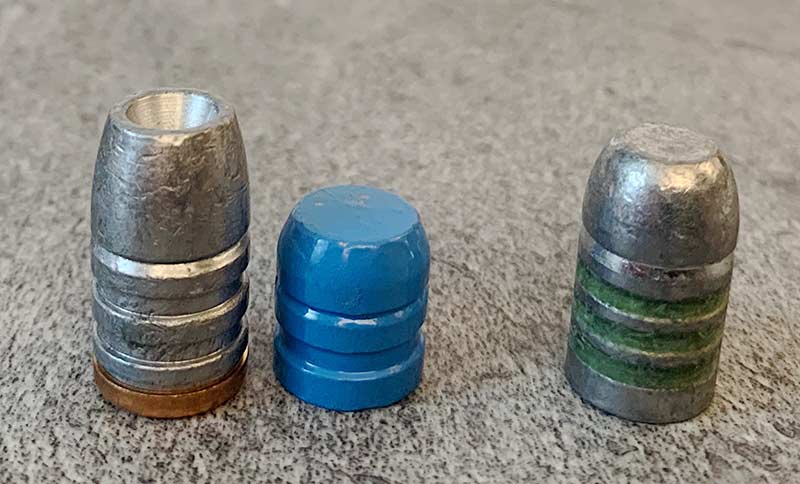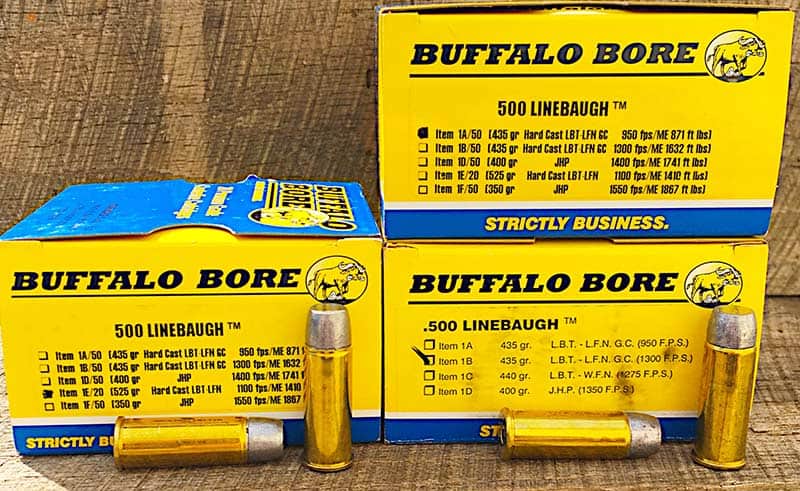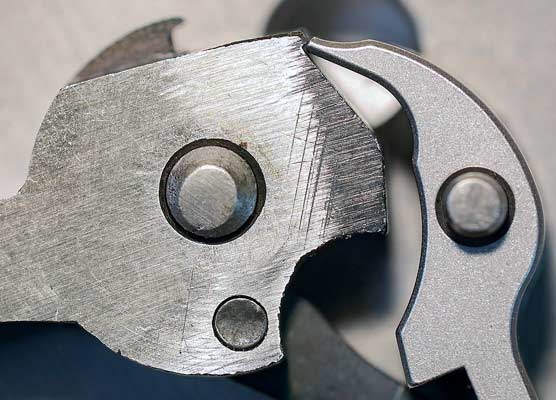John Linebaugh’s Cartridges
Sir Samuel Baker stated, “Bullet diameter and weight are constant, velocity is the only diminishing characteristic.” This statement is the heart and soul of big bore enthusiasts. Large diameter, heavy bullets, at moderate velocity, drive deeper and straighter, creating larger wound channels than smaller, high velocity rounds.
Chamber a gun with a cartridge having these characteristics, in a compact, packable handgun and you have exactly what John Linebaugh strives for with the guns he builds. Naturally, we’re talking about the cartridges he designed, bearing his name, the .500 and .475 Linebaugh cartridges.
Linebaugh considers himself a student of Elmer Keith, picking up where the master left off, with his cartridge and gun designs, and famed hunter, John “Pondoro” Taylor — also a fan of large, heavy bullets, at moderate velocity, for large, dangerous game.
The .500 Linebaugh
John came out with the .500 Linebaugh in 1986. Using cutdown .348 Winchester rifle brass as the parent cartridge, he shortened it to 1.405” and used jacketed bullets of .510” diameter or cast lead bullets of .512 or .513”. Ballistic performance from a packable 5.5” revolver shows 435 grain bullets going 1,300 FPS and 525 grain bullets doing 1,100 FPS for plenty of smackdown on large critters.
Magnum Research is the only factory manufacturer of five-shot single action revolvers for the .500 Linebaugh cartridge. Custom makers John Linebaugh, Hamilton Bowen, and Ronnie Wells, along with a few others, convert large-framed Ruger revolvers with custom five-shot cylinders enabling the chambering of the large .500 Linebaugh cartridge.
John Linebaugh told me years ago his .500 does the same as his .475, at half the pressure. I’d wanted a .500 Linebaugh ever since I heard those words.
Got Brass?
Finding a reliable source of .348 Winchester brass in the late ‘80s was tough and led to the development of the .475 Linebaugh a couple of years later. The .45-70 is the parent cartridge of the .475 Linebaugh, cut down to 1.4”. What developed was a cartridge with essentially the same bullet weights driven at the same velocities as the .500, but with better sectional density, due to the smaller bullet diameter — making them better penetrators.
It was a win-win situation for users of big bore revolvers. Now, companies such as Starline Brass make both .475 and .500 Linebaugh, in factory fresh batches, for our convenience. Availability is no longer a problem.
The .475 Linebaugh
My personal .475 Linebaugh has quite the track record. It was originally won in a raffle at a Linebaugh seminar by the father of a good friend of mine, Chuck Smith. The gun was later traded to another friend, Glenn Swaggart, who eventually sold it to me several years ago. It is a classic Linebaugh gun including a custom free spinning cylinder, integrally banded front sight base, smooth action and very accurate.
Favorite loads for my .475 Linebaugh include an MP Molds 385 grain radiused flat-nose hollow point. Loaded over 14.5 grains of HS-6, velocity running over 1,160 FPS. Another favorite is a LEE Precision 400 grain radiused flat-nose design. Loaded over the same 14.5 grains of HS-6, it runs just shy of 1,100 FPS. Lighter loads using 10 grains of Unique powder drives the MP bullet over 970 FPS and the LEE slug 920 FPS for easy shooting practice loads.
Factory manufactured .475’s are made by Magnum Research and Freedom Arms. Customs are made again by John Linebaugh, Hamilton Bowen, Ronnie Wells and others.
Magnum Research BFR .500 Linebaugh
A few years ago, Magnum Research offered an Elmer Keith commemorative from their custom shop. You know how every now and then you see a gun and you know you just “have to have one?” That was me! I contacted Brett Pikula, who runs the custom shop, and ordered one. Before I knew it, it was here, and I was mightily impressed!
Fit and finish is impeccable, the action is smooth and the trigger crisp and light. It even has a base-pin locking latch like Elmer Keith had on his famous #5 revolver, along with a free spinning cylinder. Here was a 5.1” barreled gun chambered for a powerful cartridge capable of launching 450 grain bullets over 1,200 FPS. You can load them hotter, but 1,200 FPS was plenty of fun for me.
I use 26 grains of 2400 with a large Winchester pistol primer, using Starline brass. Hunter’s Supply makes a dandy LFN designed bullet for those who don’t cast but want a good lead slug. Using the same 26 grains of 2400, velocity runs over 1,200 FPS.
Why?
Having a true big bore handgun is a personal choice. Who wouldn’t want to heave large chunks of lead from a hand cannon in the name of fun? Who doesn’t enjoy watching geysers of dirt and rock erupt from the impact of bullets weighing over 400+ grains of lead from a handgun? Having a finely tuned handgun having big holes in its cylinder and barrel is cool. Loading them in your gun is very satisfying as they “klunk” into their tomb, ready to be shot.
For hunters, the truly big bore handguns have no equal. Large bullets create larger wound channels. Larger wound channels leak, make that gush, lots of blood, while letting lots of air in, leading to fast expiration. We can thank John Linebaugh for picking up where Elmer Keith left off with his innovation and determination keeping the big bore school of thought alive.










